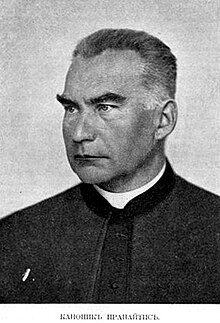|
Justinas Pranaitis
Justinas Bonaventūra Pranaitis (Russian: Иустин Бонавенту́ра Пранайтис; 27 July 1861 – 28 January 1917)[1] was a Lithuanian Catholic priest. He was a professor of Hebrew at the Saint Petersburg Roman Catholic Theological Academy and missionary in Uzbekistan. He is best known as the author of The Talmud Unmasked, and his subsequent involvement as a witness in the Bellis trial. BiographyEducation and professorshipJustinas Pranaitis was born on 27 July 1861 to a peasant family in Panenupiai near Griškabūdis in Congress Poland, client state of the Russian Empire.[2] After completing four classes at the Marijampolė Gymnasium, he enrolled at the Sejny Priest Seminary in 1878. He then continued to study at the Saint Petersburg Roman Catholic Theological Academy graduating with a Master of Theology in 1887. He was ordained priest in 1886.[2] Right after graduation, Pranaitis replaced Daniel Chwolson as the Hebrew professor at the Theological Academy. In addition, Pranaitis taught liturgy and church singing. He became prefect of the academy in 1891.[2] He brought his younger sister Julija Pranaitytė to Saint Petersburg to study at a girls' gymnasium. She later became a publisher and editor of Lithuanian books and periodicals in the United States.[3] Pranaitis supported Lithuanian cultural activities in Saint Petersburg, including the Lithuanian and Samogitian Charitable Society.[4] In 1894, Pranaitis was involved in a case of blackmail.[5] He brought a picture to be gilded, but it burned down in a framing studio. Pranaitis demanded a compensation of 1,000 rubles from the workshop for damages.[5] He claimed that it was a 17th-century painting by Bartolomé Esteban Murillo from the collection of archbishop Aleksander Gintowt-Dziewałtowski.[6] However, such painting never existed.[5] Missionary In 1895, Pranaitis was exiled to Tver for two years. In 1897, archbishop Szymon Marcin Kozłowski sent Pranaitis to survey the situation of Roman Catholics in Turkistan.[2] The following year, he visited regions of Siberia. In 1900, he left Saint Petersburg and relocated to Tashkent for missionary work among the local Roman Catholics.[2] He worked to construct churches in Tashkent (the Sacred Heart Cathedral), Samarkand (St. John the Baptist Church), Ashgabat, Gyzylarbat, Fergana as well as several chapels.[6] He established a Catholic charitable society and a few small libraries.[2] To help with construction, he built a sawmill that produced electricity.[7] He frequently traveled visiting more remote members of the congregation. To help with this task, he managed to get two railroad cars, one equipped for church needs and another with a kitchen and living space.[7] In 1909, Pranaitis accompanied auxiliary bishop Jan Cieplak to Manchuria and Japan.[2] In 1904, he published a proclamation asking for donations for a church in Tashkent. It became the first Lithuanian-language publication after the Lithuanian press ban was lifted.[8] He also published articles in the Lithuanian press, including Lietuvių laikraštis, Šaltinis, Vienybė, Viltis.[2] He also published in Polish Przegląd Katolicki.[9] Antisemitic work In 1892, Pranaitis published an antisemitic tract called Christianus in Talmude Iudaeorum in Latin, adapted from his Master's thesis, under the imprimatur of the Archbishop of Mogilev, which was subsequently translated into Polish (1892), French (1892), German (1894), Russian (1911), Lithuanian (1912), Italian (1939), English (1939) and Spanish. The English translation of the book is titled The Talmud Unmasked: The Secret Rabbinical Teachings Concerning Christians (usually shortened to The Talmud Unmasked). In 1912, Pranaitis testified in the blood libel case of Menahem Mendel Beilis in Russia. Beilis was accused of murdering a Christian child to take his blood for alleged Jewish rituals. Pranaitis was called as an expert witness to testify to the Talmudic hatred of Christians, as described in his book. His credibility rapidly evaporated, however, when the defence demonstrated his ignorance of some simple Talmudic concepts and definitions, such as hullin, erubin, Baba Batra,[10][11][12] to the point where "many in the audience occasionally laughed out loud when he clearly became confused and couldn't even intelligibly answer some of the questions asked by [Beilis'] lawyer".[13] Beilis was found not guilty. DeathPranaitis died from cancer on 28 January [O.S. 11 February] 1917 in Saint Petersburg.[9] Other sources maintain that he was killed at the hands of the Bolsheviks. He was buried by the Sacred Heart Cathedral that he worked to build in Tashkent. In 1923, the grave were destroyed by the Soviets. Bishop Pranciškus Būčys wrote 2118-page biography of Pranaitis but it remains unpublished.[2] See alsoReferences
External links |
||||||||||||||||||
